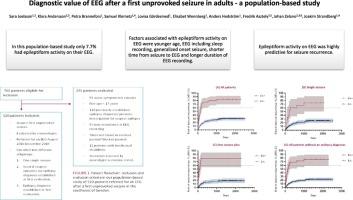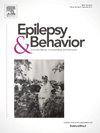成人首次非诱发性癫痫发作后脑电图的诊断价值——一项基于人群的研究
IF 2.3
3区 医学
Q2 BEHAVIORAL SCIENCES
引用次数: 0
摘要
目的脑电图(EEG)是首次非诱发性癫痫发作后的标准检查,但其在成人中的诊断价值尚不清楚。我们的目的是研究在瑞典哥德堡以人群为基础的队列中首次非诱发性癫痫发作后脑电图的诊断价值。方法:这项基于人群的回顾性研究纳入了2016年8月至2019年12月大哥德堡流域首次非诱发性癫痫发作后由神经科医生转诊的成年患者。总共纳入520例患者,并在医疗记录中随访,中位时间为4.42年(范围0.33-6.93)。主要结局指标为癫痫样活动。回顾病历,探讨脑电图对临床管理的影响。计算并比较不同亚组中癫痫样活动的频率。结果癫痫发作后中位数为70 d后记录脑电图。总的来说,7.7%的人有癫痫样活动,27.9%的人脑电图有病理性减慢。发作复发率为33.7%(29.6 ~ 37.8%)。癫痫样活动预测癫痫复发的风险为82.5%(70.7-94.3)。癫痫样活动的敏感性仅为19.2%(13.6-25.9),但特异性为98.0%(95.9-99.2),存在此类活动的相对复发风险为2.8(2.3-3.5)。脑电图结果导致4.4%的患者改变诊断和/或药物治疗。脑电图上癫痫样活动的相关因素为年龄较小、脑电图包括睡眠记录、全局性发作、从发作到脑电图的时间较短和脑电图记录时间较长。意义:成人首次非诱发性癫痫发作后较长潜伏期的脑电图记录量较低。然而,癫痫样活动高度预测癫痫复发,我们的研究结果表明,脑电图上的癫痫样活动可以进一步作为首次癫痫发作后确定癫痫的生物标志物。本文章由计算机程序翻译,如有差异,请以英文原文为准。

Diagnostic value of EEG after a first unprovoked seizure in adults – A population-based study
Objective
Electroencephalography (EEG) is a standard investigation after a first unprovoked seizure but the diagnostic value in adults remains unclear. Our objective was to investigate the diagnostic value of EEG after a first unprovoked seizure in a population-based cohort in Gothenburg, Sweden.
Methods
This retrospective population-based study included adult patients referred by a neurologist for EEG after a first unprovoked seizure from August 2016 - December 2019 in the greater Gothenburg catchment area. In total 520 patients were included and followed in medical records for a median of 4.42 years (range 0.33–6.93). Primary outcome measures were epileptiform activity. Medical records were reviewed for the influence of EEG on clinical management. The frequency of epileptiform activity was calculated and compared in different subgroup analyses.
Results
EEGs were recorded after a median of 70 days from the seizure. In total, 7.7 % had epileptiform activity, and 27.9 % had pathological slowing on their EEG. Seizure recurrence occurred in 33.7 % (29.6–37.8). Epileptiform activity predicted seizure recurrence with a recurrence risk of 82.5 % (70.7–94.3). The sensitivity of epileptiform activity was only 19.2 % (13.6–25.9) but the specificity was 98.0 % (95.9–99.2) and the relative risk of recurrence in presence of such activity was 2.8 (2.3–3.5). The EEG findings resulted in an alteration of diagnosis and/or medication in 4.4 % of the patients. Factors associated with epileptiform activity on EEG were younger age, EEG including sleep recording, generalized onset seizure, shorter time from seizure to EEG and longer duration of EEG recording.
Significance
The yield of EEG recorded with a longer latency after a first unprovoked seizure in adults was low. However, epileptiform activity highly predicted seizure recurrence and our results suggest that epileptiform activity on EEG could be explored further as a biomarker for defining epilepsy already after a first seizure.
求助全文
通过发布文献求助,成功后即可免费获取论文全文。
去求助
来源期刊

Epilepsy & Behavior
医学-行为科学
CiteScore
5.40
自引率
15.40%
发文量
385
审稿时长
43 days
期刊介绍:
Epilepsy & Behavior is the fastest-growing international journal uniquely devoted to the rapid dissemination of the most current information available on the behavioral aspects of seizures and epilepsy.
Epilepsy & Behavior presents original peer-reviewed articles based on laboratory and clinical research. Topics are drawn from a variety of fields, including clinical neurology, neurosurgery, neuropsychiatry, neuropsychology, neurophysiology, neuropharmacology, and neuroimaging.
From September 2012 Epilepsy & Behavior stopped accepting Case Reports for publication in the journal. From this date authors who submit to Epilepsy & Behavior will be offered a transfer or asked to resubmit their Case Reports to its new sister journal, Epilepsy & Behavior Case Reports.
 求助内容:
求助内容: 应助结果提醒方式:
应助结果提醒方式:


